
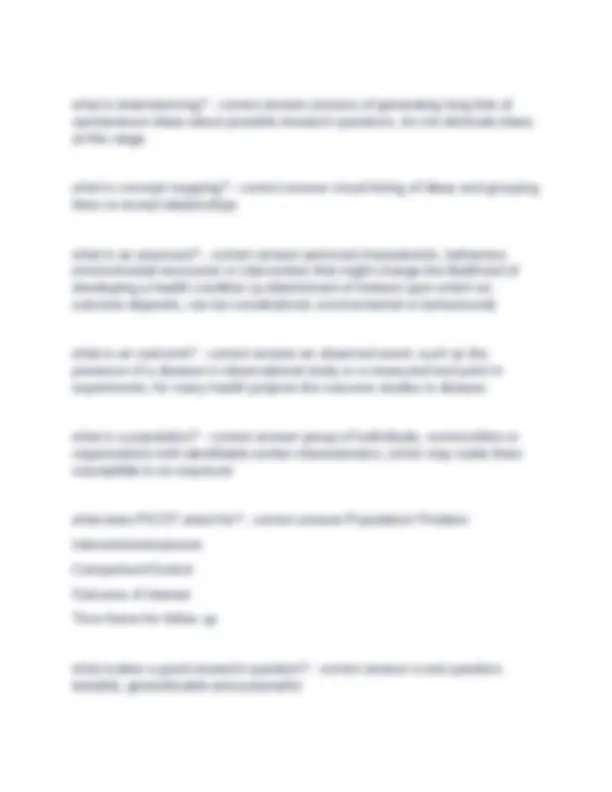


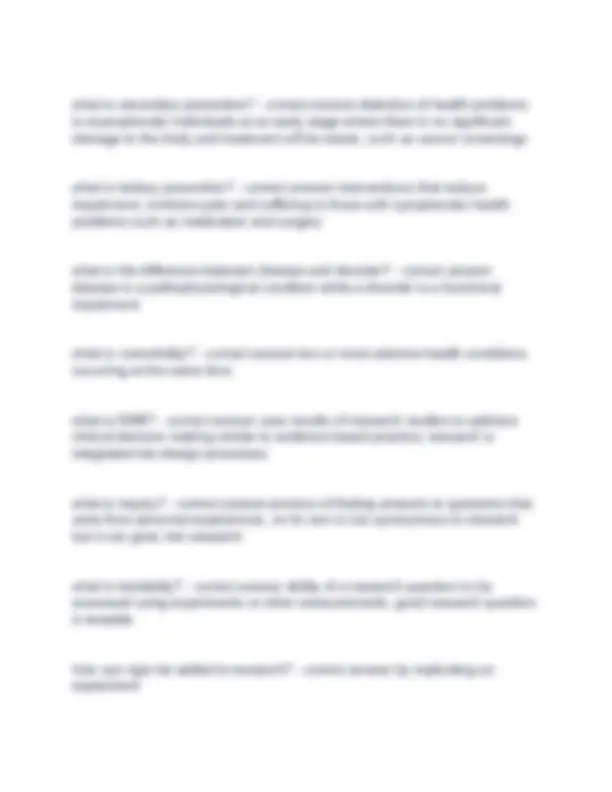

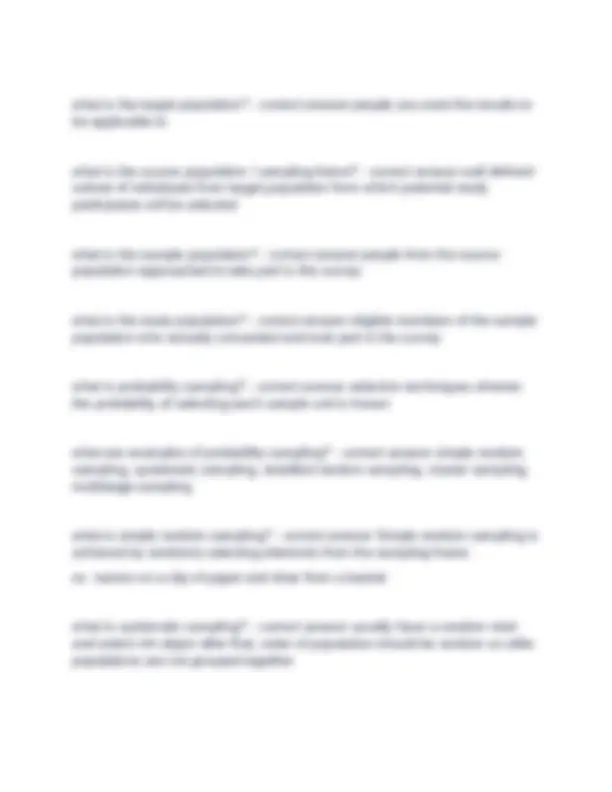
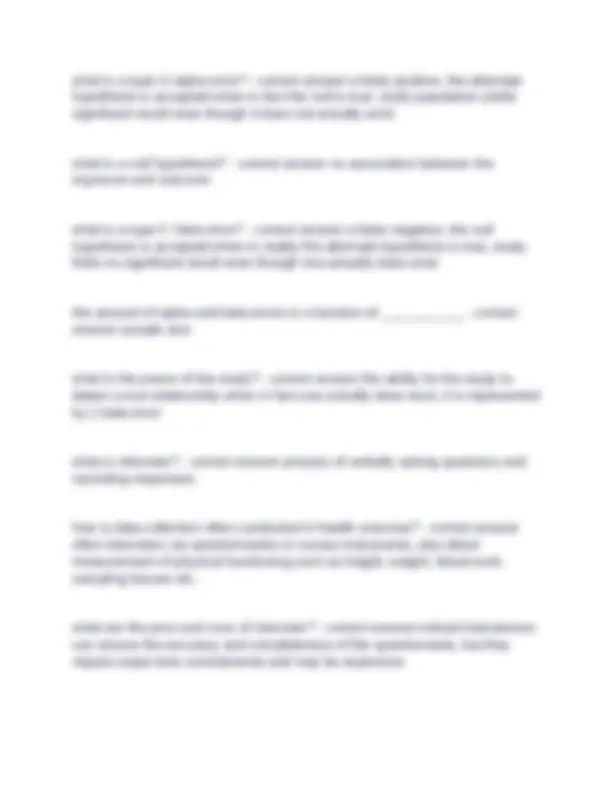


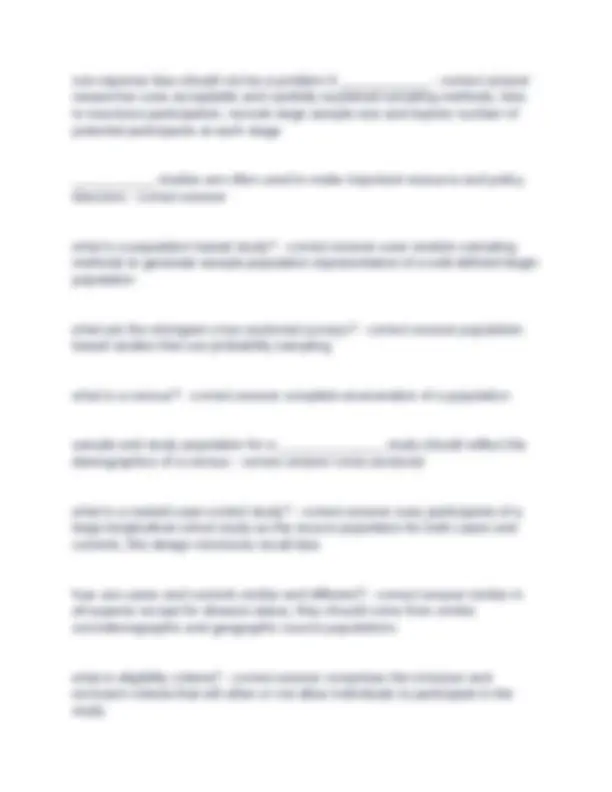





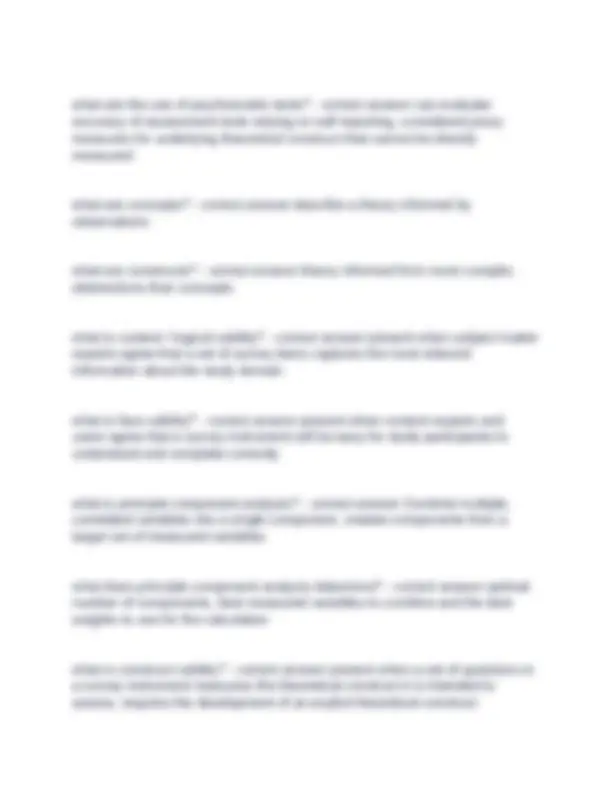


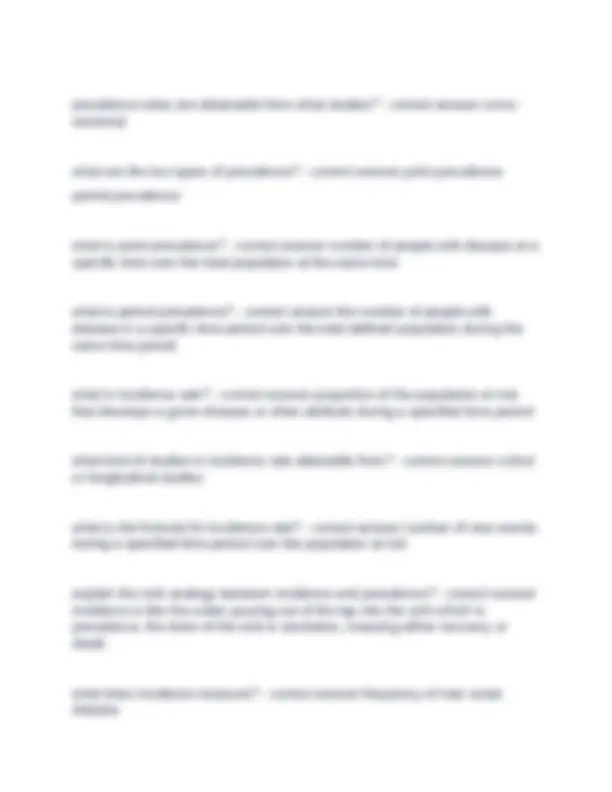


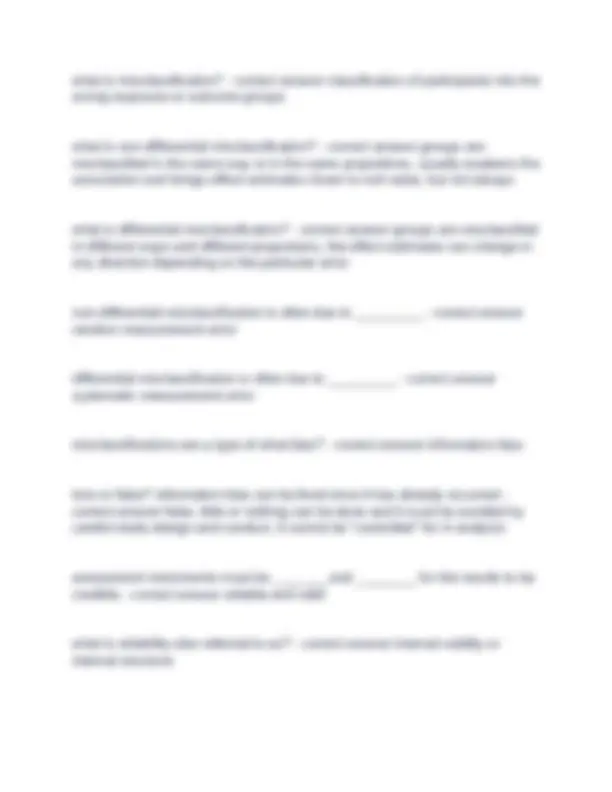
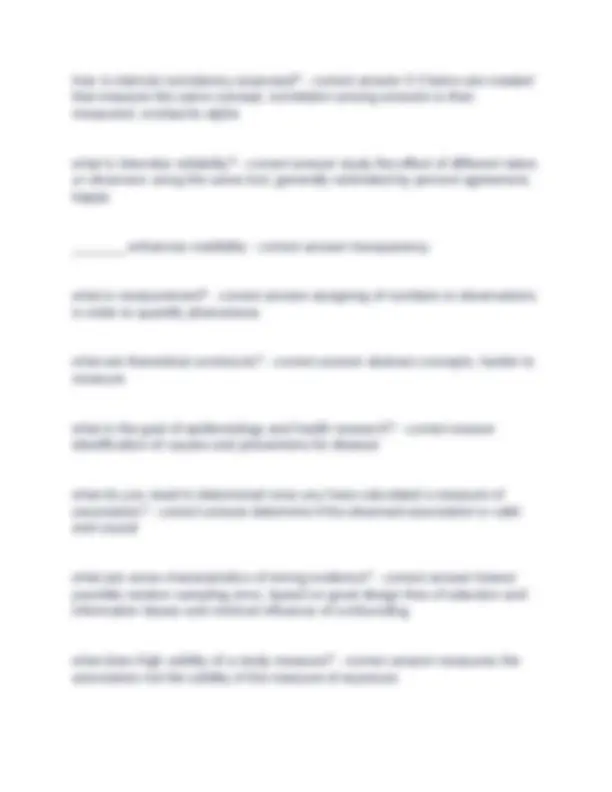
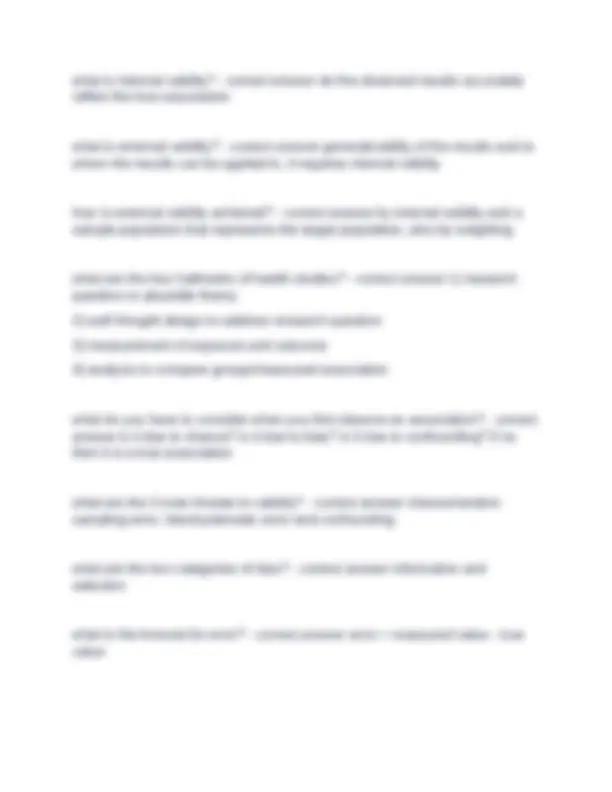




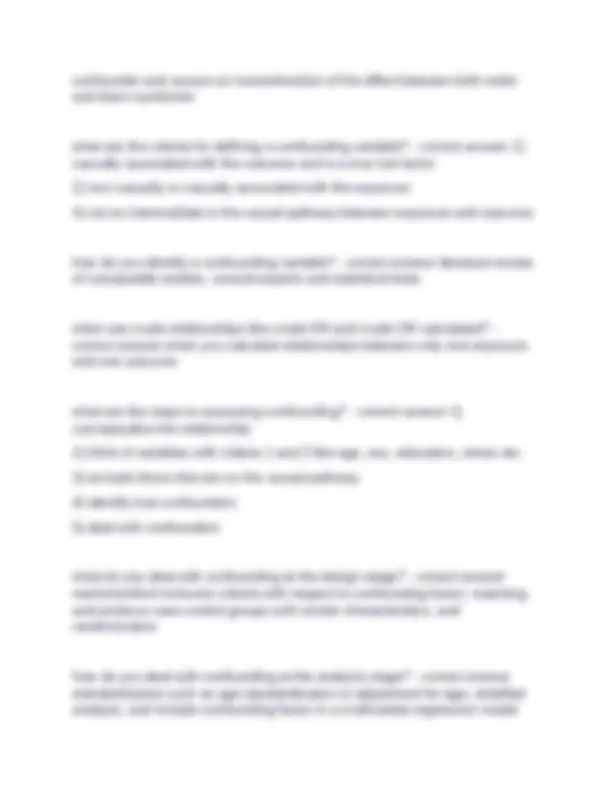


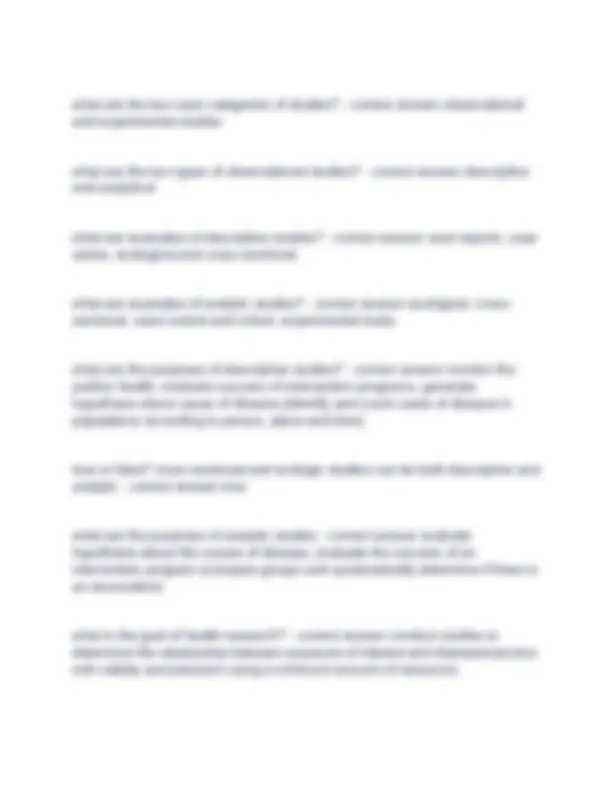
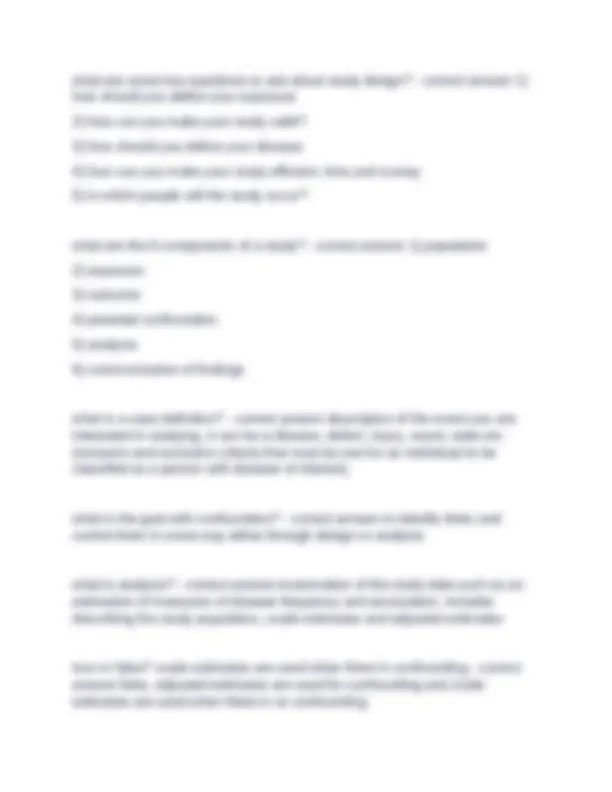
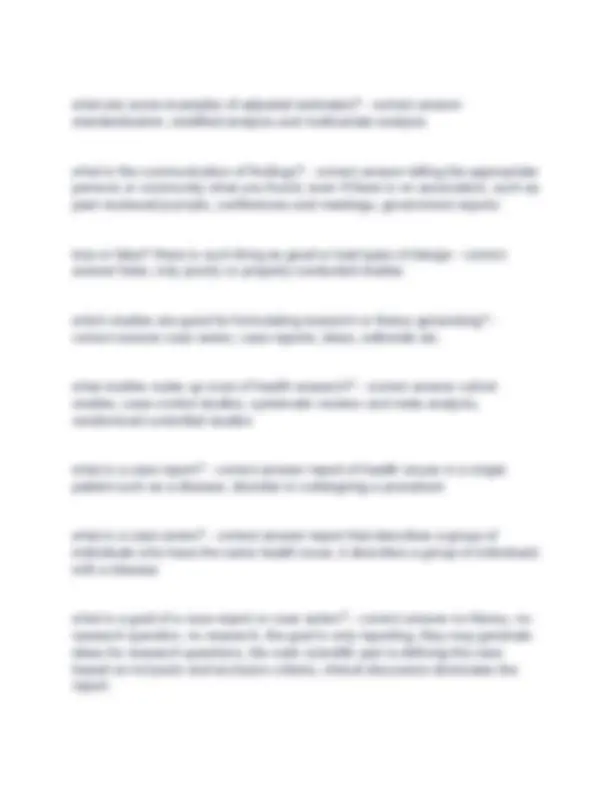
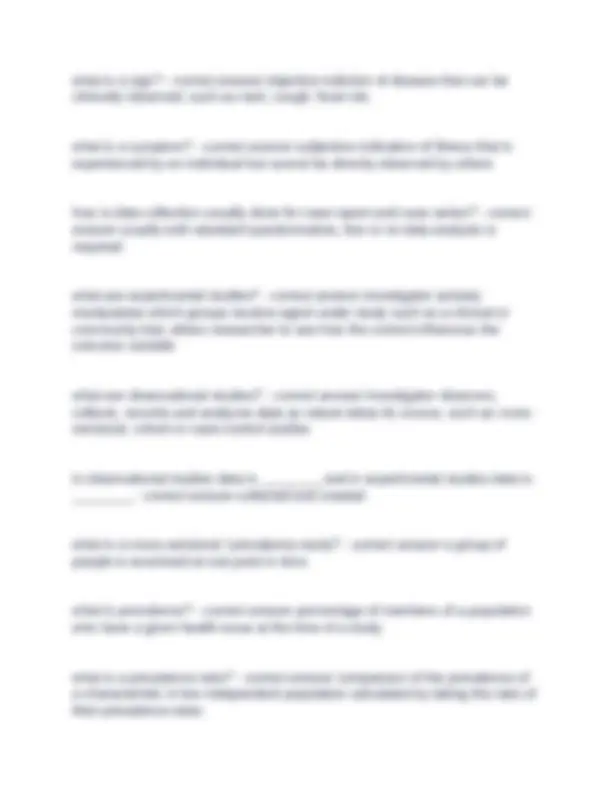


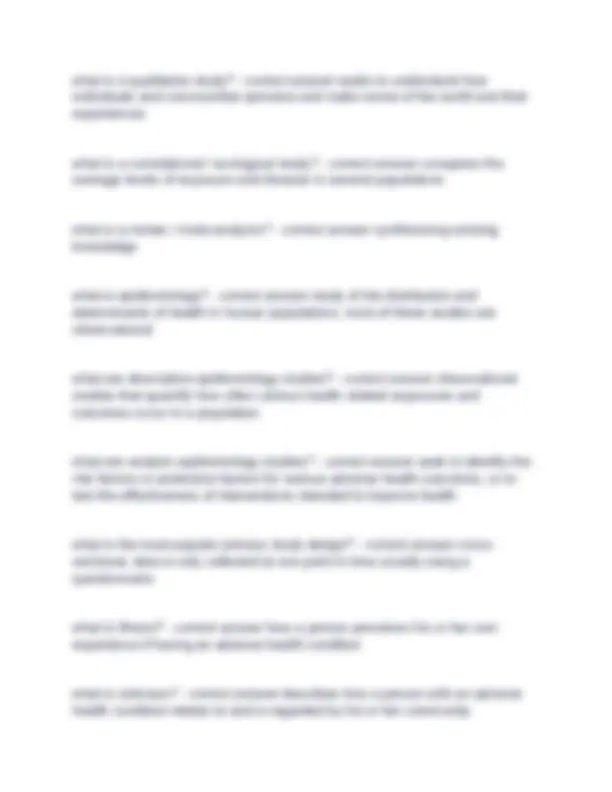

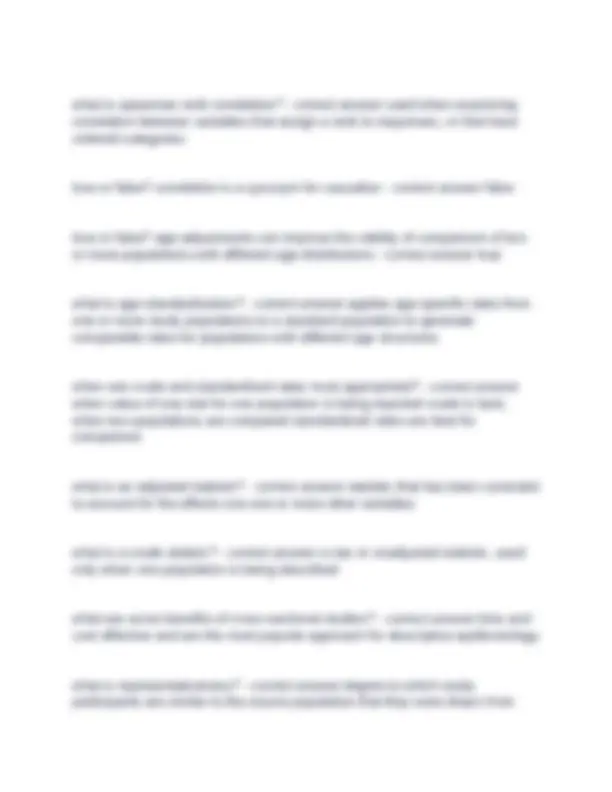
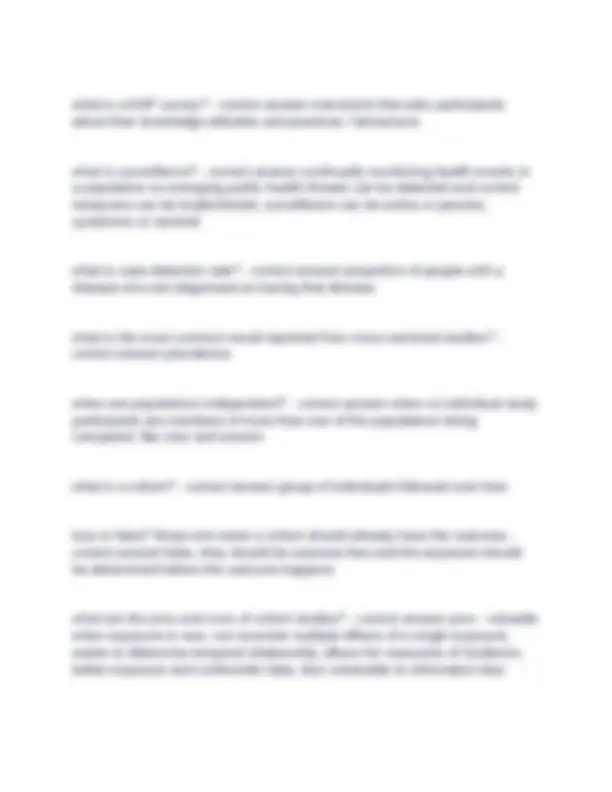
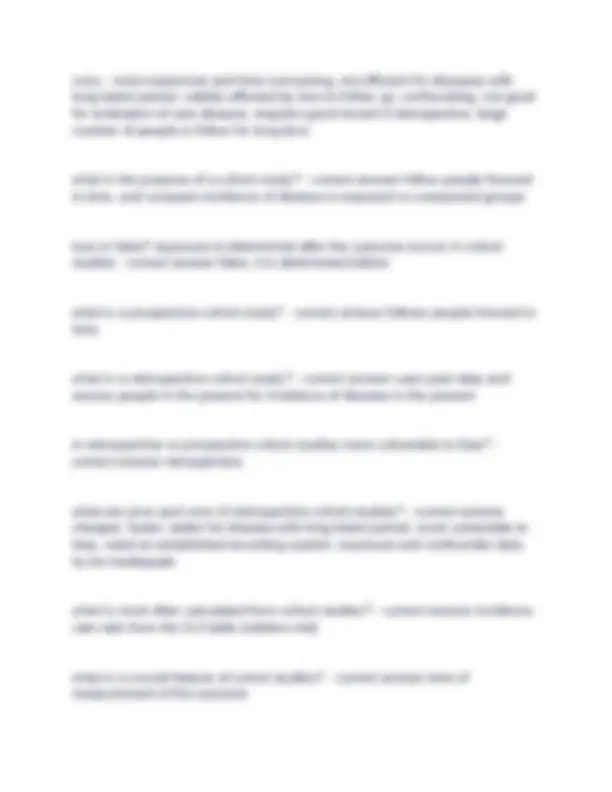

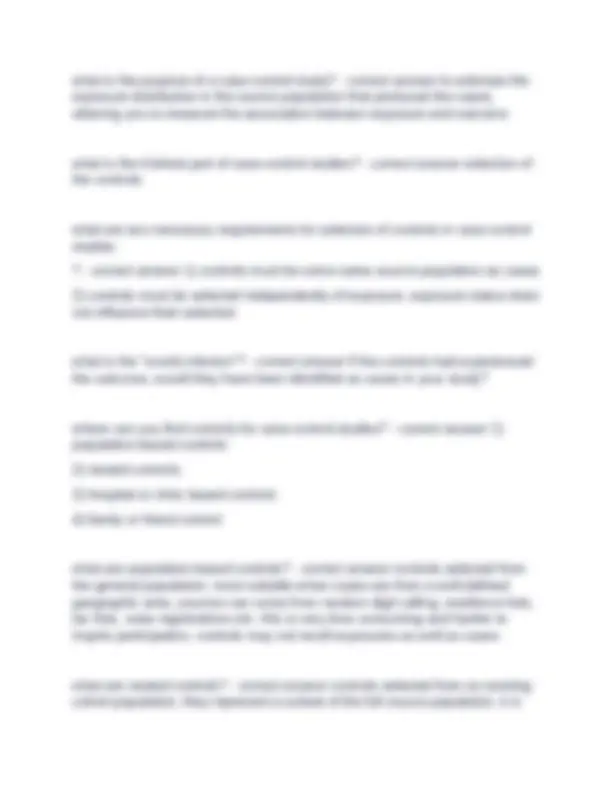

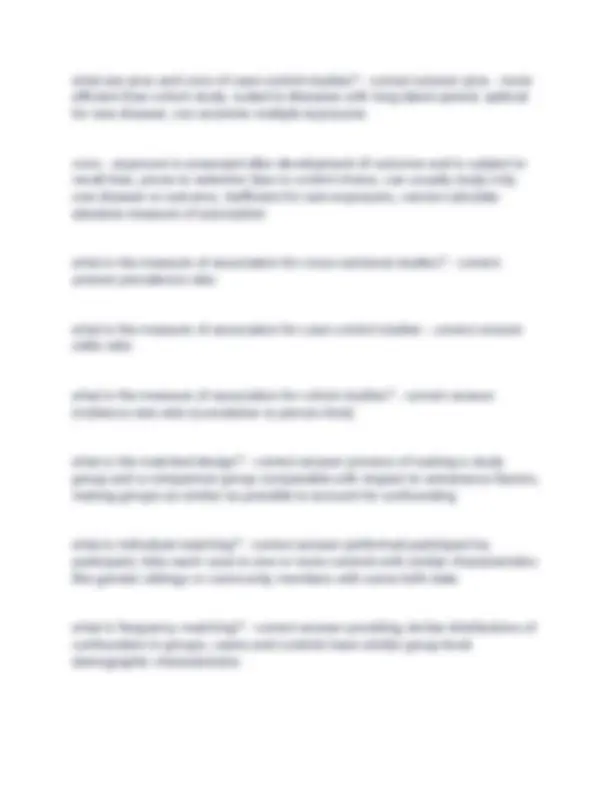

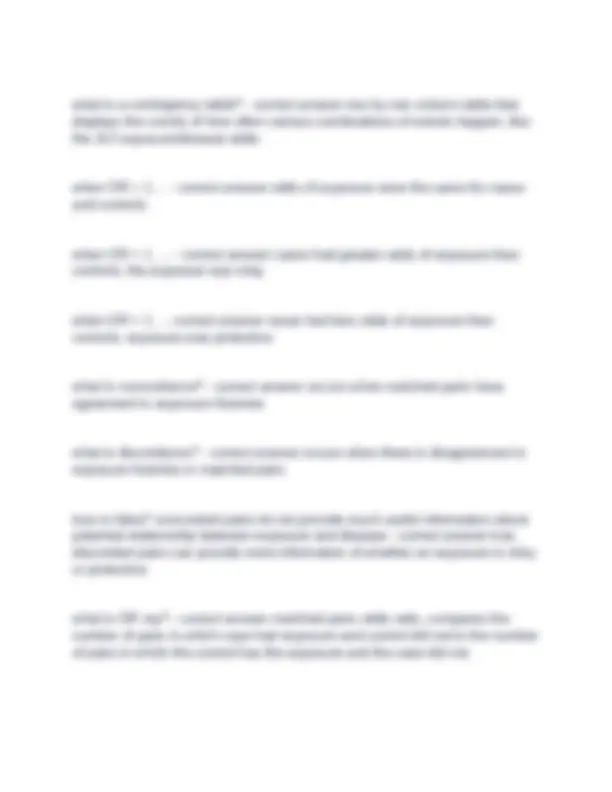


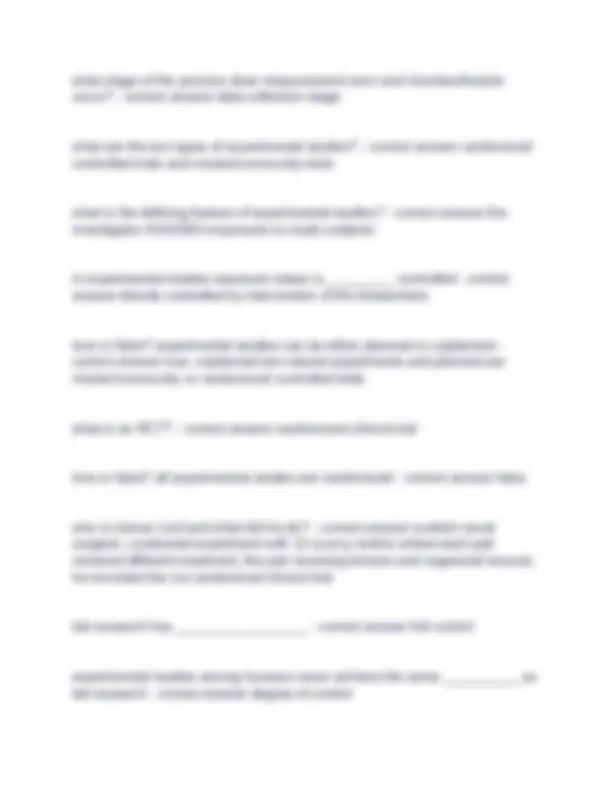

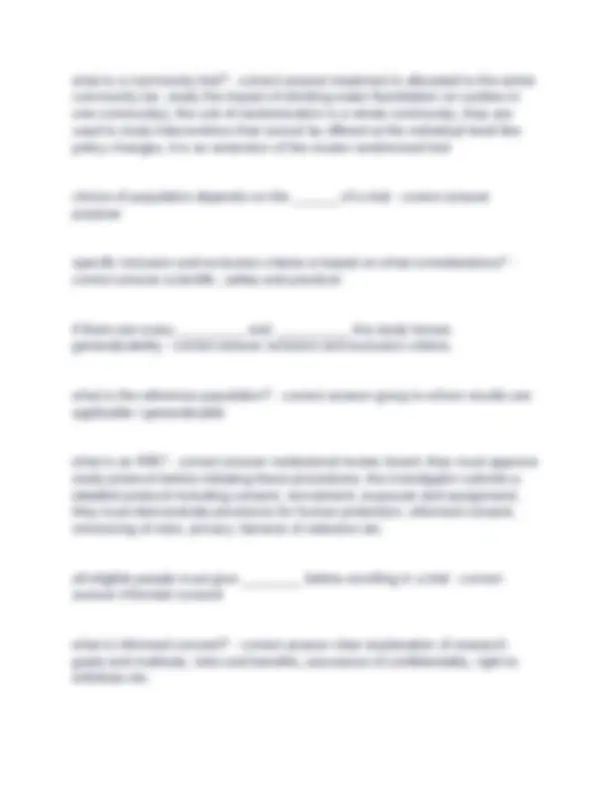


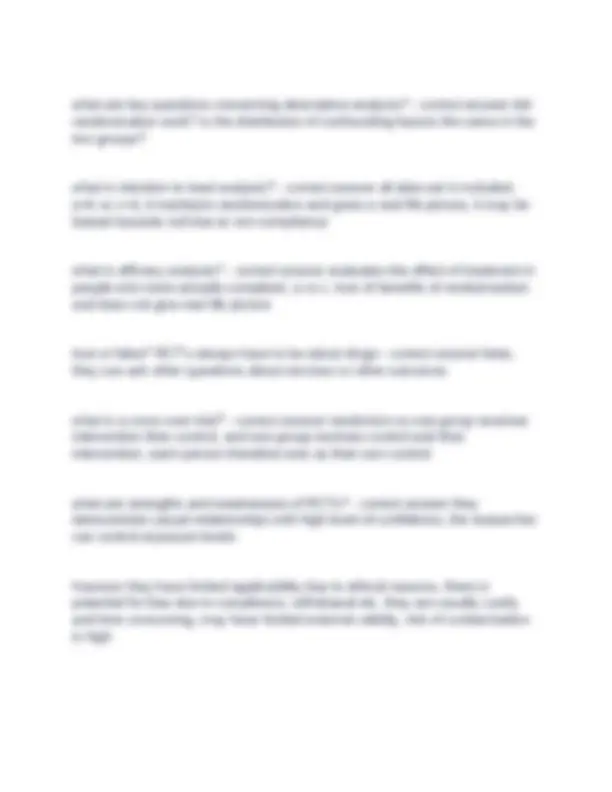
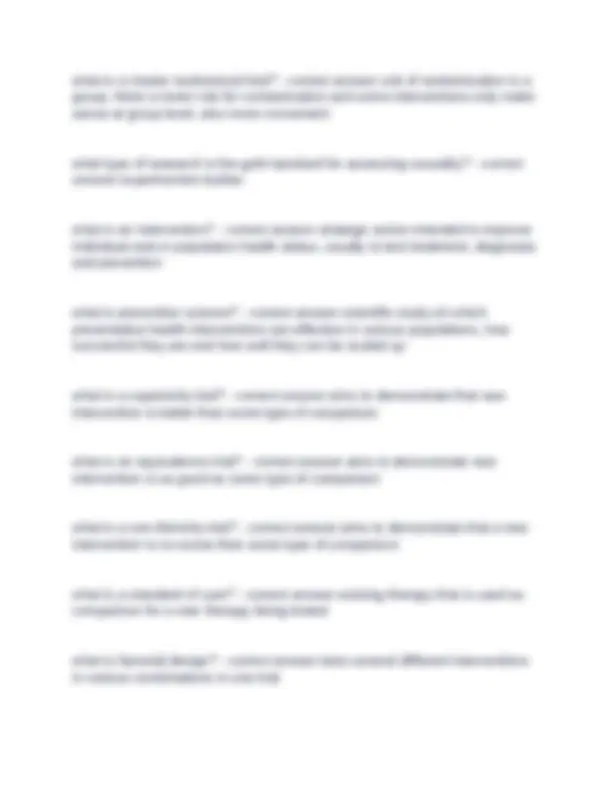
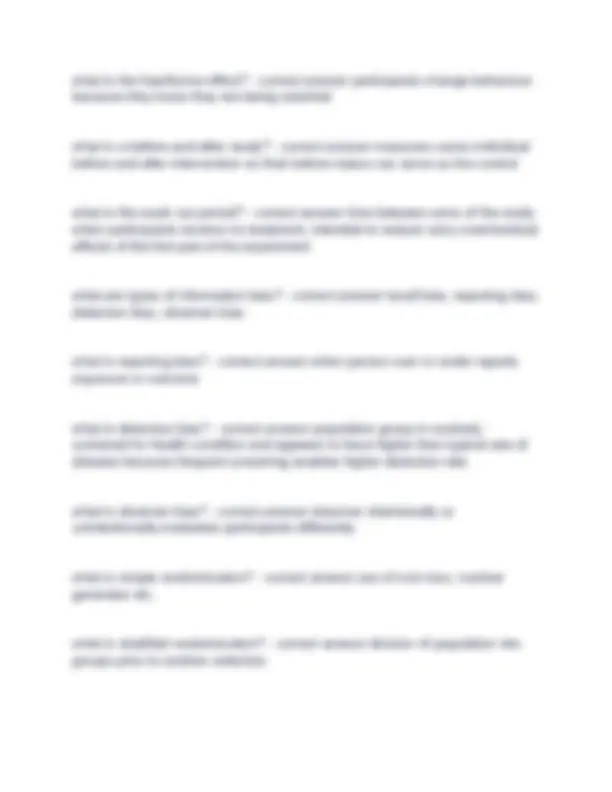
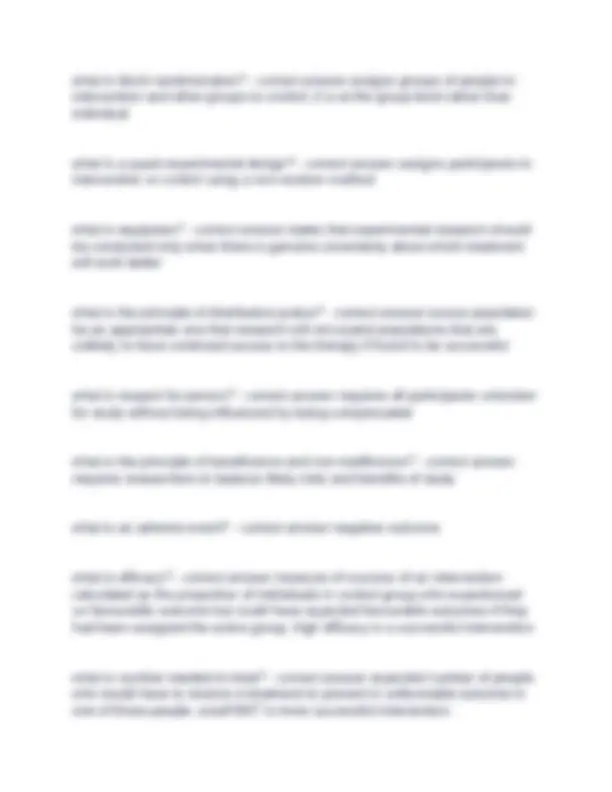
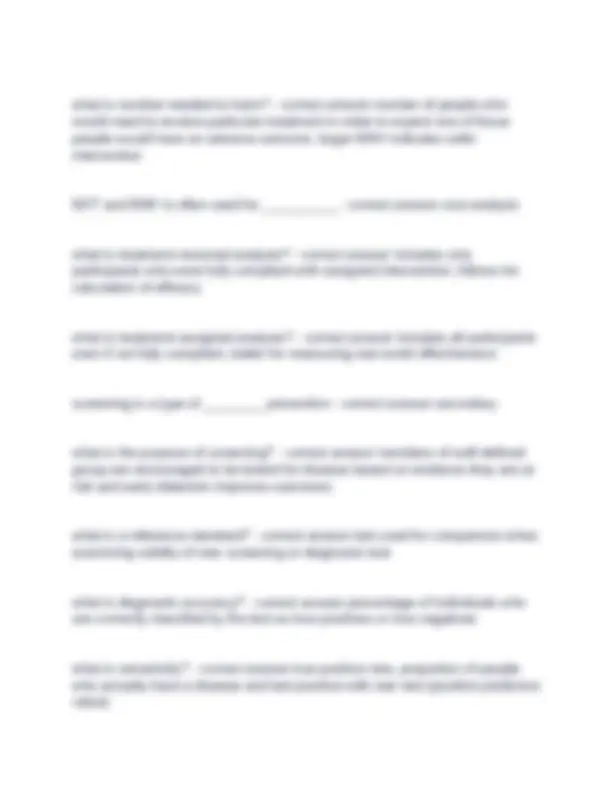




Study with the several resources on Docsity

Earn points by helping other students or get them with a premium plan


Prepare for your exams
Study with the several resources on Docsity

Earn points to download
Earn points by helping other students or get them with a premium plan
Community
Ask the community for help and clear up your study doubts
Discover the best universities in your country according to Docsity users
Free resources
Download our free guides on studying techniques, anxiety management strategies, and thesis advice from Docsity tutors
HS 2801 MIDTERM REVIEW Question and answers 100% correct 2025
Typology: Exams
1 / 70

This page cannot be seen from the preview
Don't miss anything!































































what is health? - correct answer a state of complete physical, mental, and social well-being and not merely the absence of disease or infirmity what is research? - correct answer activities designed to develop or contribute to generalizable knowledge like theories, principles, relationships that can be confirmed or refuted by recognized methods of observation, experiment and inference what is health research philosophically? - correct answer biological, behavioural and social science research on all aspects of human health and disease what is health research applied? - correct answer process of systematically investigating a single well defined aspect of physical, mental or social well being health research makes the connection between _________ and __________ - correct answer determinants and health what is epidemiology? - correct answer study of the distribution and determinants of health-related states in specific populations, and the application of this study to control health problems, it focuses more on the reasons behind a disease what is biostatistics? - correct answer application of statistics to biological and medial problems, measures associations, correlation, significance in epidemiology, toxicology and other public health sciences
what are determinants of health? - correct answer biological, behavioural, social, environmental, political and other factors that influence the health status of individuals and populations what are the three types of research? - correct answer clinical, population health and biological what is clinical research? - correct answer evaluates best ways to prevent, diagnose, and treat health issues that adversely affect individuals and families, similar to the focus of medicine in that it focuses on the individual as unit of investigation what is population health research? - correct answer focuses on the health outcomes and the determinants of health in groups of humans/populations, similar to the focus of public health which is the action part of population research what is biological / basic medial research? - correct answer looks at changes at the human cellular level that can be related to health outcomes, most methods are lab methods, studies genes, cells, molecules etc. related to human function what are the 6 steps of the research process? - correct answer 1) identify study question
what is generalizability in research? - correct answer information that can be applicable beyond the study population what is a study goal? - correct answer the single overarching objective of a research project or the main question that a research project seeks to answer what are specific aims? - correct answer carefully described action that will help the researcher make progress towards achieving the big picture goal most studies in the health sciences have _________ specific aims - correct answer 2-4, with an average of 3 what are sequential specific aims? - correct answer chronological list of actions that will achieve the main goal, each specific aim lays the foundation for the next one what are independent specific aims? - correct answer related but independent objectives, when one is not achieved it will not prevent succesful completion of the next good specific aim/objective can be summarized by _________ - correct answer SMART what is a theoretical framework? - correct answer set of established models in the published literature that can inform the components and flows of the conceptual framework for a new research study what is the Lalonde model? - correct answer first modern government document in western society producing the health field concept to look beyond the biomedical health care system to encourage population health, published in 1974
what are the 4 components of the Lalonde model? - correct answer 4 components of the health field concept are human biology, environment, lifestyle and health care organization what are the components of the eco-social model? - correct answer the individual, microsystems, mesosystems, exosystems, macrosystem and chronosystem what is a conceptual model? - correct answer model that a researcher sketches using boxes and arrows to illustrate various relationships what is EDP? - correct answer exposure, disease, population, questions ask is such and such exposure related to such disease in such population intervention is synonymous to ___________ - correct answer exposure objective should address the ______ - correct answer gap in the body of literature health research encompasses what two types of research? - correct answer clinical and population health research what is medicine? - correct answer practice of preventing, diagnosing and treating health problems in individuals and families what is a clinician? - correct answer a medical professional that has direct interaction with paitents
what is usually the next step after brainstorming? - correct answer developing a list of key words what are MeSH? - correct answer medical subject headings are a vocab thesaurus that can be used in health science data based, it can help you move from a vague interest to a more focused one, it can also do the reverse many topics in health research are expressed by the formula ___________ - correct answer [exposure] and [disease/outcome] in [population] where keywords are filled in to generate questions health research often seeks to determine if exposures are __________ or _________ - correct answer protective or risky what is a risk factor? - correct answer exposure that increases the likelihood of experiencing a particular disease or outcome what is a protective factor? - correct answer exposure that decreases the likelihood of experiencing a particular disease or exposure what is a non-modifiable risk factor? - correct answer one that cannot be changed through health interventions such as age, genetics etc. what is a modifiable risk factor? - correct answer factor that can be avoided or mitigated through intervention what is primary prevention? - correct answer health behaviours that keep an adverse health event from occurring like diet, sleep, exercise, vaccinations etc.
what is secondary prevention? - correct answer detection of health problems in asymptomatic individuals at an early stage where there is no significant damage to the body and treatment will be easier, such as cancer screenings what is tertiary prevention? - correct answer interventions that reduce impairment, minimize pain and suffering in those with symptomatic health problems such as medication and surgery what is the difference between disease and disorder? - correct answer disease is a pathophysiological condition while a disorder is a functional impairment what is comorbidity? - correct answer two or more adverse health conditions occurring at the same time what is EMB? - correct answer uses results of research studies to optimize clinical decision making similar to evidence based practice, research is integrated into design processes what is inquiry? - correct answer process of finding answers to questions that arise from personal experiences, on its own is not synonymous to research but it can grow into research what is testability? - correct answer ability of a research question to be answered using experiments or other measurements, good research question is testable how can rigor be added to research? - correct answer by replicating an experiment
what is the target population? - correct answer people you want the results to be applicable to what is the source population / sampling frame? - correct answer well defined subset of individuals from target population from which potential study participants will be selected what is the sample population? - correct answer people from the source population approached to take part in the survey what is the study population? - correct answer eligible members of the sample population who actually consented and took part in the survey what is probability sampling? - correct answer selection techniques wherein the probability of selecting each sample unit is known what are examples of probability sampling? - correct answer simple random sampling, systematic sampling, stratified random sampling, cluster sampling, multistage sampling what is simple random sampling? - correct answer Simple random sampling is achieved by randomly selecting elements from the sampling frame. ex. names on a slip of paper and draw from a basket what is systematic sampling? - correct answer usually have a random start and select nth object after that, order of population should be random so alike populations are not grouped together
what is stratified random sampling? - correct answer random samples selected from distinct groups such as geography or sex, a certain amount from each stratum are selected what is cluster sampling? - correct answer uses natural clusters rather than individual units, and observations/data is collected on all units of the cluster ex. is selecting random schools in a community and every member from selected schools are sampled what is multistage sampling? - correct answer primary sampling units are selected, such as cluster or stratum, and secondary units are selected within primary units what are convenience samples? - correct answer selection is from a non- probability based source population due to ease of access, such as certain schools, workplaces etc. must be used with caution because these sources are often different from target and source populations they are intended to represent what is purposive sampling? - correct answer recruitment of participants for a qualitative study based on the special insights they can provide what are key informants? - correct answer those selected to participate in a qualitative study because they have expertise relevant to the study question what is selection bias? - correct answer healthier or educated people are more likely to volunteer for research, therefore members of study population are not representative of source population, it is a systematic error in the way participants are selected or retained in a study, individuals have different probabilities of being included or retained in the study, participation differs on exposure and disease
what is a type 1/ alpha error? - correct answer a false positive, the alternate hypothesis is accepted when in fact the null is true, study population yields significant result even though it does not actually exist what is a null hypothesis? - correct answer no association between the exposure and outcome what is a type II / beta error? - correct answer a false negative, the null hypothesis is accepted when in reality the alternate hypothesis is true, study finds no significant result even though one actually does exist the amount of alpha and beta errors is a function of ___________ - correct answer sample size what is the power of the study? - correct answer the ability for the study to detect a true relationship when in fact one actually does exist, it is represented by 1-beta error what is interview? - correct answer process of verbally asking questions and recording responses how is data collection often conducted in health sciences? - correct answer often interviews via questionnaires or survey instruments, also direct measurement of physical functioning such as height, weight, blood work, sampling tissues etc. what are the pros and cons of interview? - correct answer trained interviewers can ensure the accuracy and completeness of the questionnaire, but they require major time commitments and may be expensive
what is a self administered survey? - correct answer questionnaire form that participants complete by themselves how is data often collected in qualitative studies? - correct answer spending 1- 2 hours interviewing key informants using open ended questions what is a semi-structured interview? - correct answer interviewer stars with a list of open ended questions that will be asked, but they are merely starting points for eliciting responses what is probing? - correct answer interview technique that prompts an interviewee to provide a more complete or specific response true or false? interviewers can also record the body language and other non- verbal communicated conveyed by participants - correct answer true what are the pros and cons of administered surveys - correct answer they are cost and time efficient and have possibility to approach a large number of participants, and are the best way to get honest answers to sensitive questions, however they are problematic for low literacy populations and those with limited technology access all interviewers should undergo __________ - correct answer role specific training, and have an opportunity to practice interview skills, pilot testing and quality control what is interviewer bias? - correct answer interviewers systematically question cases and controls or exposed and unexposed members of a study population differently, such as only probing those they believe to have a disease of interest
what is pilot testing? - correct answer small scale preliminary study conducted to evaluate feasibility of a full scale research project what are some practical considerations for questionnaire design? - correct answer order of questions, getting the correct answer, data recording methods, layout and formatting, back translation and pilot testing when is stratified sampling done? - correct answer when you want more, less or the same amount of people from one stratum than others what is a major concern with cluster sampling? - correct answer clusters are often similar people what is the difference between cluster and convenience sampling - correct answer choice what does 20% beta error mean? - correct answer relationship will be found 80% of time if it actually exists what is likely to happen if the power of a study is low? - correct answer you miss the relationship more often you want the ________ sample size that can give ________ data - correct answer lowest, useful how do you increase power of a study? - correct answer increase sample size
why do type 1 and 2 errors occur? - correct answer sampling and random selection, they are not caused by human error type 1 and 2 errors are _________errors - correct answer random sampling errors how can you fix random sampling errors? - correct answer nothing except increase sample size what is sampling / ascertainment bias? - correct answer individuals sampled for a study are not representative of the source population what is non-random sampling bias? - correct answer each person in the source population does not have equal chance of being selected for the sample population what are probability based sampling methods? - correct answer methods that ensure all members of a source population have equal likelihood of participation what is a connivence population? - correct answer non-probability based source population selected due to ease of access who will the study population consist of? - correct answer members of sample population who can be located, consenting and meet eligibility criteria what is participation rate? - correct answer percentage of members from sample population who are in the study, 100% is rare
what is the goal of data collection for qualitative studies? - correct answer data saturation, a time in the research process when no new information is emerging because variation across population members have already been captured when should connections with community representatives be established? - correct answer early in the planning process true or false? community buy in often improves participation and enhances cultural appropriateness - correct answer true what is sample size in terms of statistics? - correct answer number of observations in a data set what is sample size in terms of health science? - correct answer the number of individual humans in the study population what is a confidence interval? - correct answer statistical estimate of the range of likely values of a parameter in a source population based on the value of that statistic in a study population, the answer likely lies somewhere in the range narrow CI indicates _________ - correct answer more certainty about the value of a statistic, good precision and less random sampling error wider CI indicates ________ - correct answer less certainty about the value of a statistic, poor precision
large data sets have CI's that are normally _________ - correct answer narrower true or false? large sample size makes it more likely that a study will yield a significant result? - correct answer true, the CI will be narrower indicating more certainty as well what is a sample size calculator? - correct answer tool used to identify an appropriate number of participants to recruit for a quantitative study what is an error? - correct answer difference between the value obtained from a study population and the true value in the larger population that occurs by chance what is bias? - correct answer a flaw in the way the study is designed or conducted that leads to inaccurate results, a systematic error in the design or conduct of a study what is the difference between errors and bias? - correct answer errors occur by change and bias is a systematic flaw probability of type 1 error is often noted by ______ - correct answer alpha most studies use alpha _______% as the value for statistical significance - correct answer 5%, corresponding to a 95% CI and a p value of 0. probability of type 2 error is often noted by _______ - correct answer beta what is the best way to minimize beta errors? - correct answer large sample size